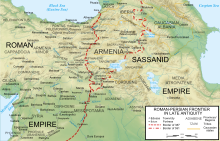
Citharizum (Greek: Κιθαρίζων) was a town and fortress on the south arm of the Euphrates[1] in the Roman province of Armenia III. It was a place of great strength which was built by the emperor Justinian and was the residence of one of the five prefects whom that emperor placed over Roman Armenia with the title of “Dux.”[2]
According to Procopius of Caesarea, the city was located in the Asthianene region.[3] The fortress was separated from Theodosiopolis (ancient Armenia) by a journey of four days.[4] Balabitene, a region between Masius and Anti-Taurus, north of Commagene and Mesopotamia, is also discussed as a possible location. Citharizum is often associated with the modern village of Keteriz.[5][6][7]
Although only a small town, it was an important point of defence for the Byzantine Empire against the Persians. Justinian built a castle there, in which he stationed a garrison under the command of a duke.[5][8][9] In 613, it was taken by Ashot, a general of the Persian king, Chosroes II.[5]
- ^ "The Classical Gazetteer". Archived from the original on 2007-03-05. Retrieved 2014-09-07.
- ^ Dictionary of Greek and Roman Geography (1854), Citharizon
- ^ Procopius, Buildings Book III, University of Chicago
- ^ Procopius, History of the Wars Book II, Chapter XXIII, en.wikisource.org
- ^ a b c Sophrone Pétridès, "Citharizum" in Catholic Encyclopedia (New York 1908)
- ^ Titular Episcopal See of Citharizum, gcatholic.org
- ^ Others associate ancient Kitharizon with the present-day location Yeni Köy. Map 89 Armenia, princeton.edu
- ^ Raymond Janin, v. Citharizum, in Dictionnaire d'Histoire et de Géographie ecclésiastiques, vol. XII, Parigi 1953, col. 997
- ^ Antoine-Augustin Bruzen de La Martinière, Le Grand dictionnaire géographique, historique et critique (1768), p. 436